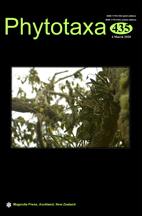Abstract
A new freshwater diatom species Pinnularia baetica sp. nov. is described from two different ponds from the Mediterranean area: Andalucia (South of Spain) and Lake Livadičko, Serbia. The species is described by observations under light (LM) and scanning electron microscopy (SEM). The most similar taxa to P. baetica are P. atlasii and P. infirma that were studied through material obtained in lagoons of northern Morocco (locus classicus of P. atlasi). Although there are similarities in the morphological characters of the frustule, it was possible to verify both through LM and SEM observations, clear differences between P. baetica and the latter two taxa: Pinnularia baetica has a panduriform shape more pronounced than P. infirma and larger valve size. On the other hand, the absence of spines in P. baetica, the more convergent striation at the poles and a slightly wider valve are the main differences with P. atlasi. This paper documents the distribution areas of P. baetica in calcareous systems of oligotrophic mid-mountain ponds of Spain and Serbia.

